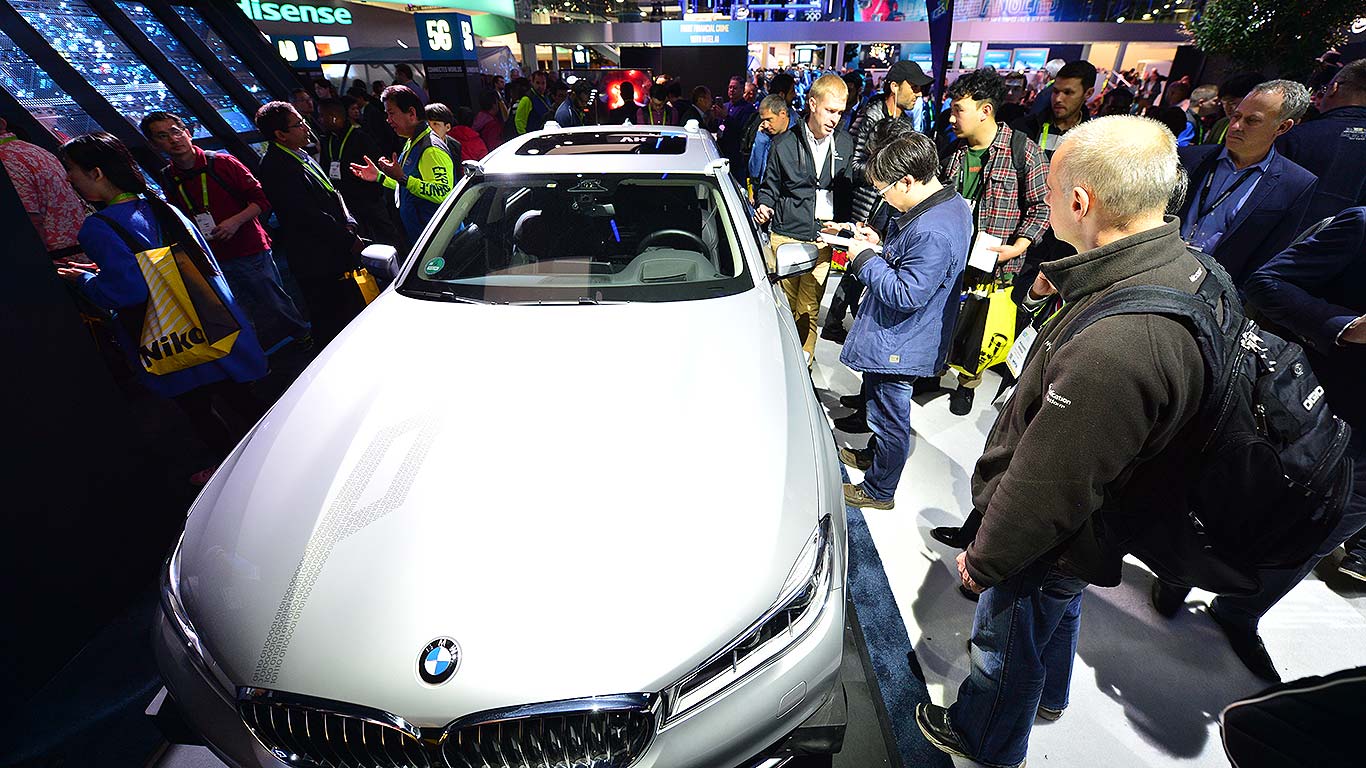 One of the most important auto shows of the world isn’t actually a pure motor show, but try telling that to all the automotive firms and tech suppliers showing their latest at CES 2018 in Las Vegas.
One of the most important auto shows of the world isn’t actually a pure motor show, but try telling that to all the automotive firms and tech suppliers showing their latest at CES 2018 in Las Vegas.
CES is where future trends are first revealed, and where deals to create the high-tech cars of the future are made. Tomorrow’s cars are going to be high-tech showcases on wheels: here’s our first look at the cool car tech coming to showrooms soon.
Level 4 cars by 2021
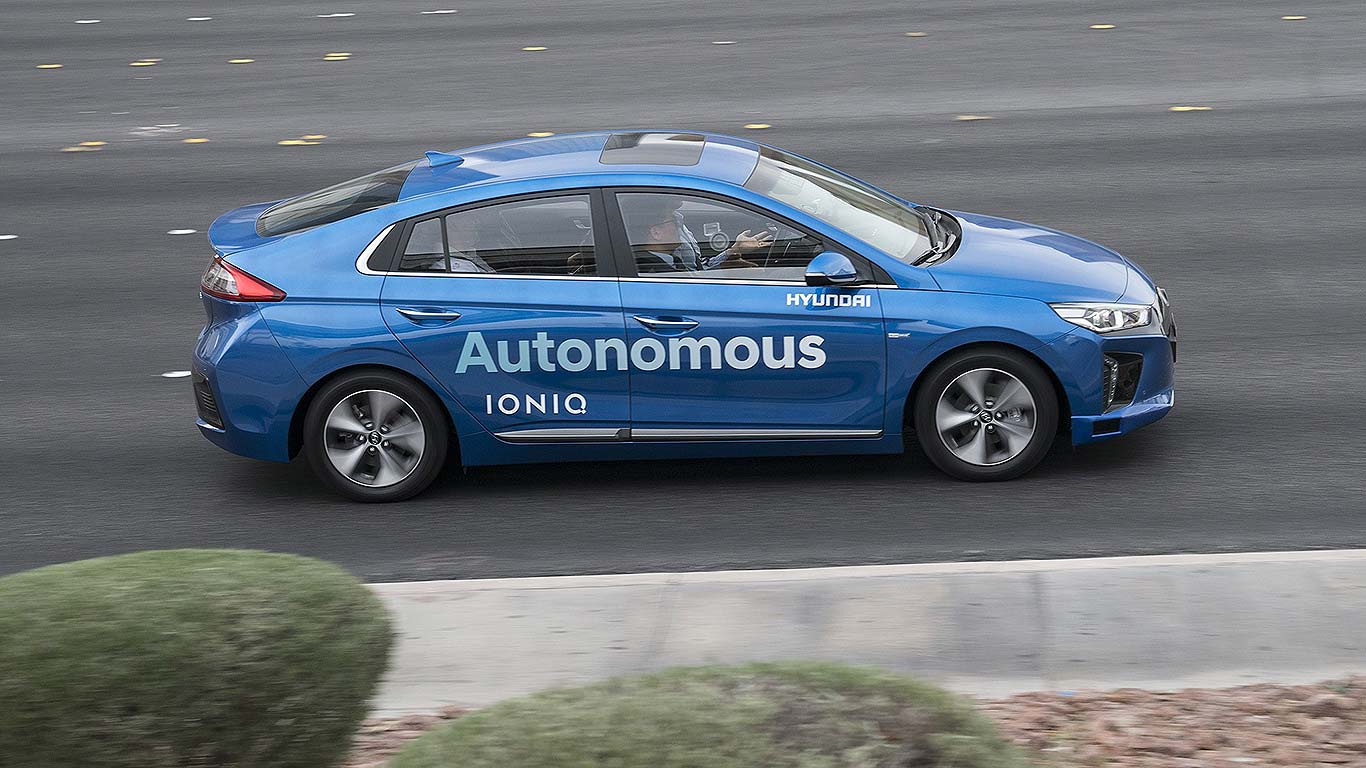
Big news: the general consensus from CES 2018 is that 2021 will be the year of the Level 4 autonomous car. These will be better than today’s Level 3 cars, which require the driver to be alert and ready to take over at any point. You can’t relax in a Level 3 car. You will be able to sit back and chill in a Level 4 car.
They’ll only be allowed to operate in selected areas and on certain roads, but the cars will then fully run without human input or oversight. The scenario is, say, driving yourself to the motorway, then letting the car take over until you reach your exit junction. Many big brands promised at CES 2018 to commercialize Level 4 cars in key large cities from 2021: in other words, in just three years’ time, the truly autonomous car might, in its earliest form, finally be here.
Instead of filling this review with promises from brands such as Hyundai, Kia, Volkswagen and others about their Level 4 self-driving cars, we’re instead going to look at the cool cars and the tech themselves. Starting with, what else, an electric SUV.
Byton SUV concept
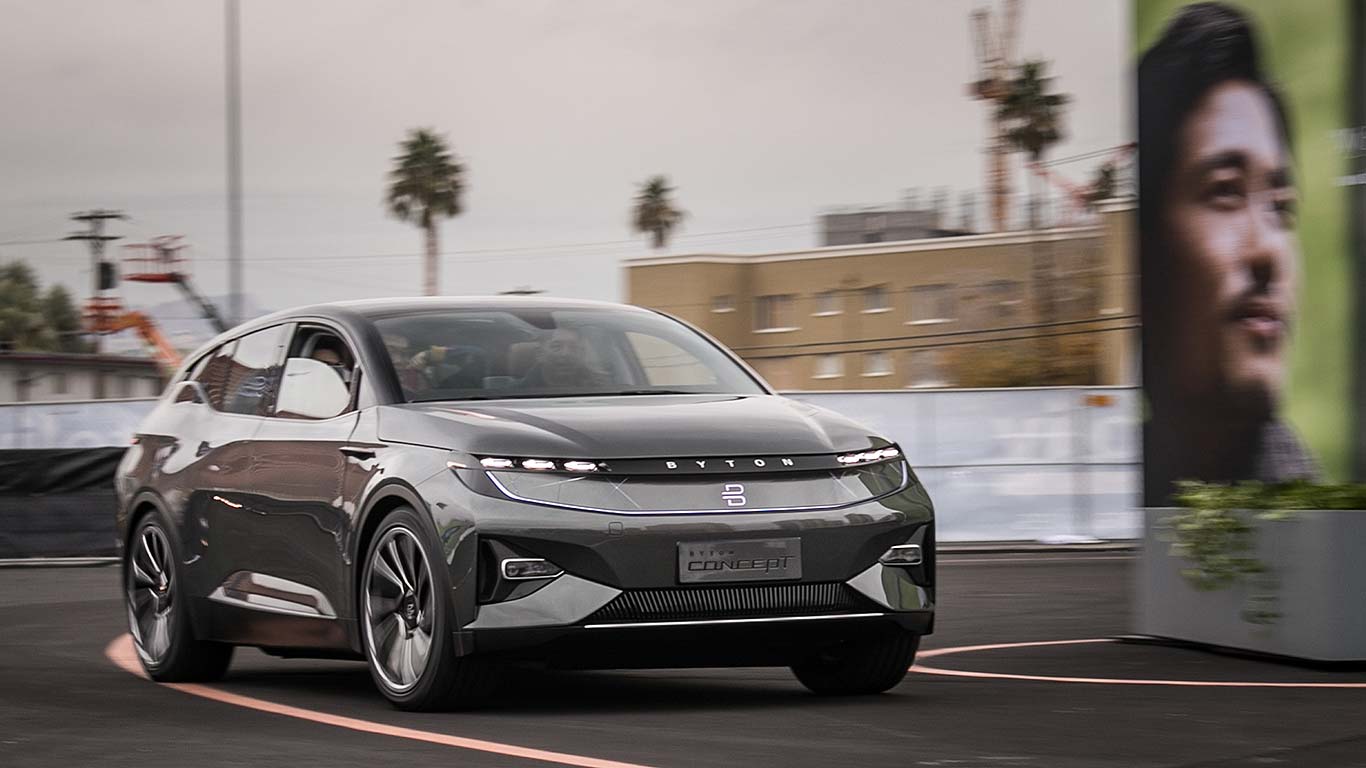
A brand-new car from an all-new automaker was revealed at CES 2018. Chinese startup Byton debuted a new all-electric SUV that it estimates will cost from $45,000 (that’s just over £33,000), will roll out in China in late 2019 and both Europe and the U.S. from 2020, and is promising to ‘redefine’ the SUV in the upcoming era of autonomous cars.
Two models will be offered, a 268 horsepower rear-wheel drive model, and a 469 hp dual-motor all-wheel drive version. Byton is promising a range of over 380 miles on a single charge of the mid-size SUV’s top-spec 95 kWh battery pack (cheaper rear-drive cars offer a 71 kWh battery and a 295-mile range). In time, an SUV and MPV will be derived from the SUV’s flexible platform.
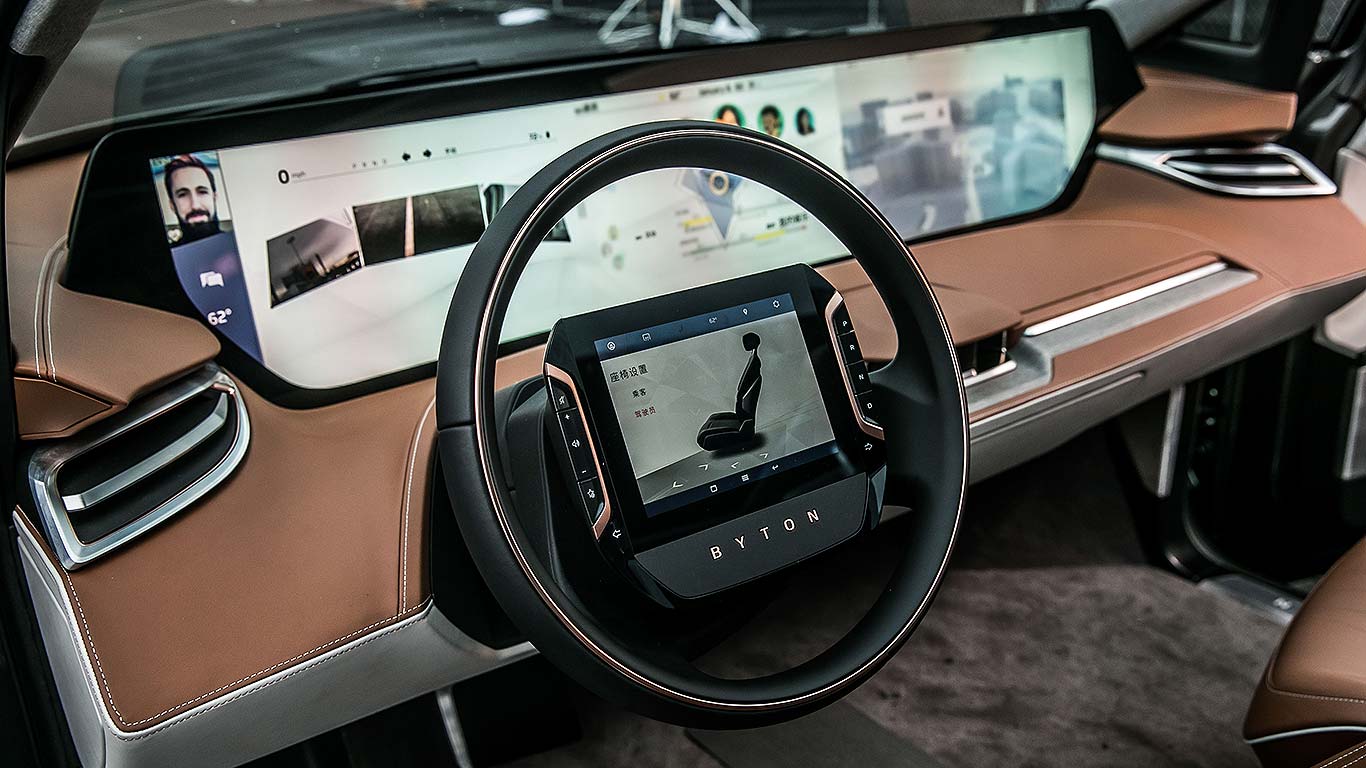
The standout is its massive infotainment screen inside. Measuring 125 cm x 25 cm (that’s 49 inches x 9.8 inches), the whopping screen is called the ‘Shared Experience Display’ and is augmented by a further three additional display screens, one of them mounted in the steering wheel itself.
There are new ways of interacting with it, including biometrics and gesture control, and Byton’s built in Amazon Alexa for intelligent voice control. Other smart details include a facial recognition entry system, 5G-ready onboard hardware, machine learning functionality and multiple user profiles which are automatically downloaded from the cloud. But it’s not all future-focused: we love the optional wooden floor…
Fisker eMotion
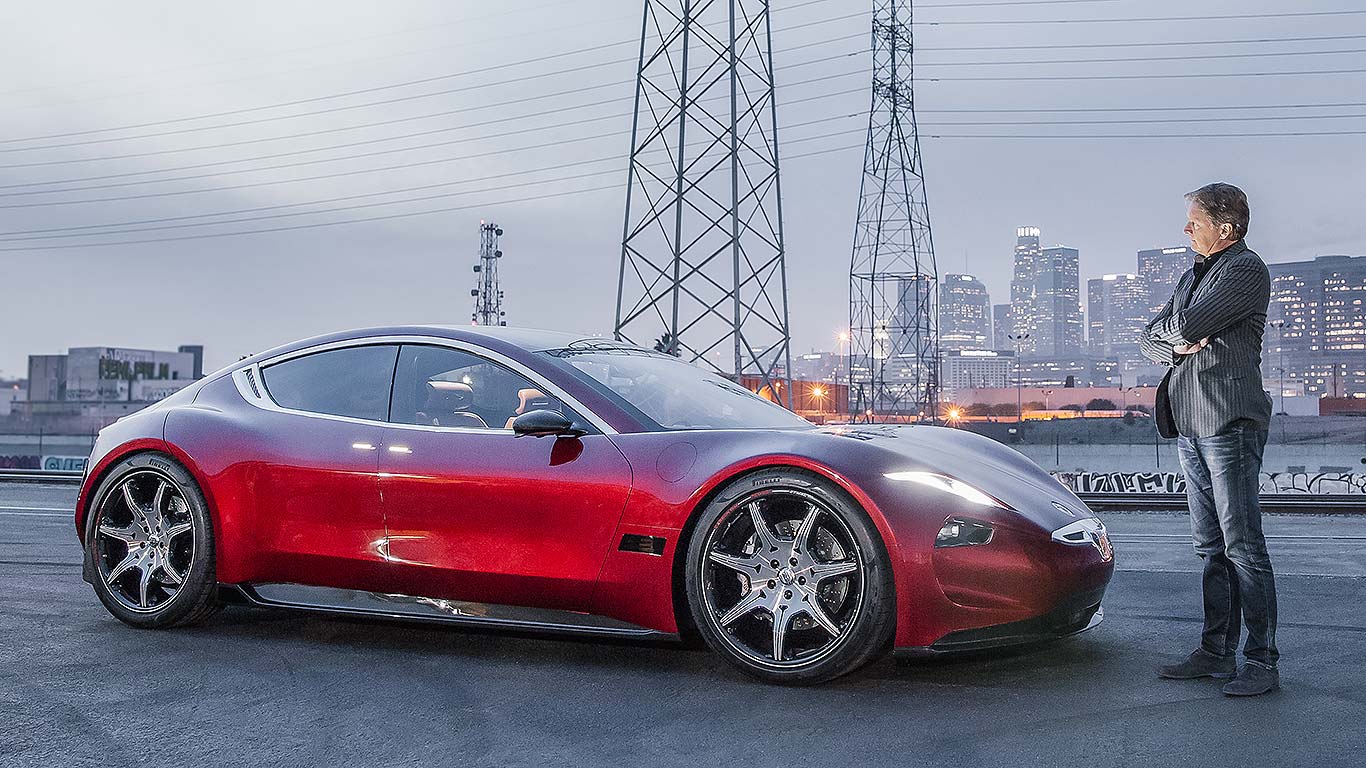
Former Aston Martin designer Henrik Fisker is back, with the latest car from his eponymous auto firm. It’s called eMotion and, as the name suggests, it’s a full EV with groundbreaking (and patent-pending) flexible solid-state batteries.
Considered the holy grail of EVs, solid-state batteries boast 2.5 times the energy density of today’s lithium ion cells, “shattering conventional thought on EV range and charge times”, says Fisker. There’s talk of the 160mph eMotion offering electric drive ranges of over 500 miles on a single charge – with charging times “as low as one minute”. Exciting stuff, which could be ready to go into cars from 2020.
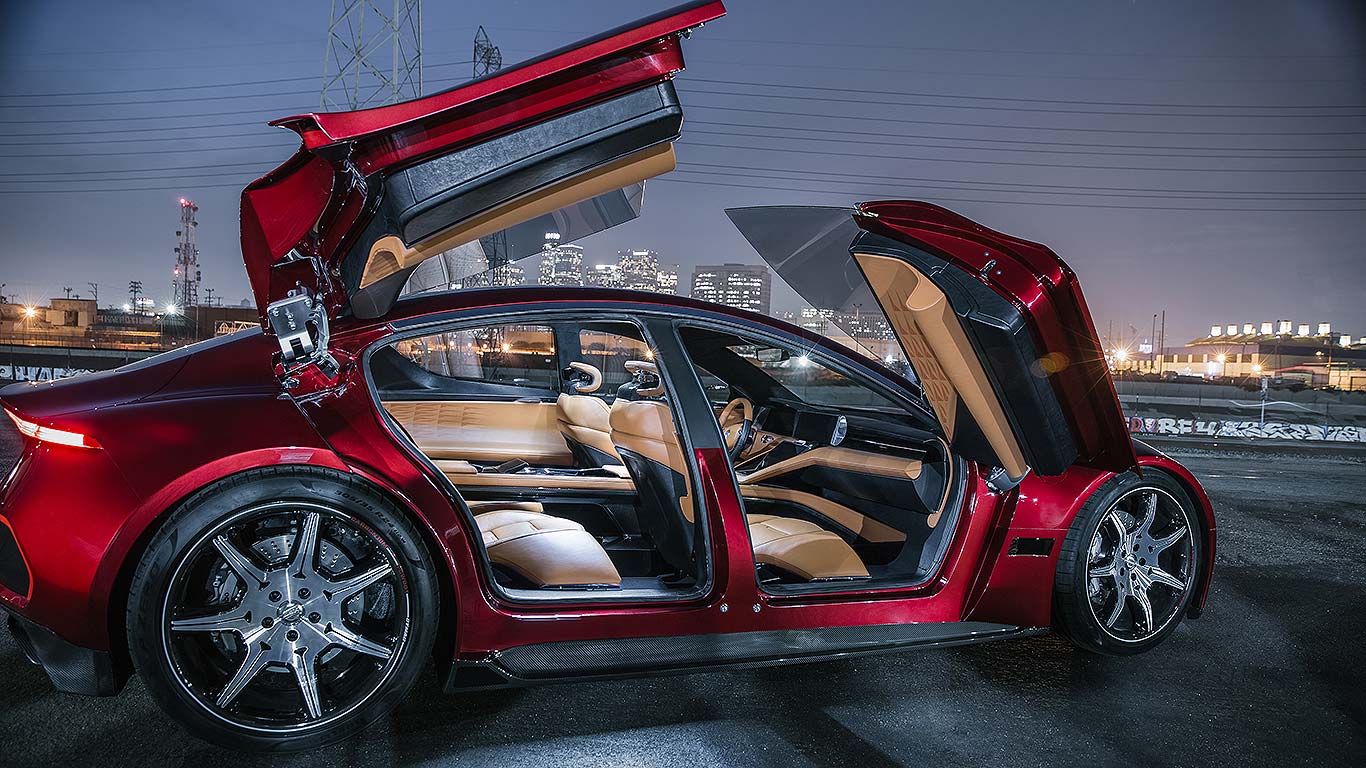
But its batteries are not the only reason to get excited about the eMotion. Just look at it. Svelte and sexy, huh? Hard to believe it’s being pitched as a five-seat alternative to a luxury car, one still offering five seats within those amazing butterfly doors, and a lavish interior fully future-proofed with next-gen tech.
It’s naturally going to be autonomous. Five fully-integrated LIDAR sensors take it up to Level 4 autonomy, and these too are packed with patents. Fisker himself feels the eMotion places the firm “clearly at the forefront” of a revolutionary new era in automobiles. A new era that will be here sooner than we think, too: production of the eMotion is confirmed, will be in the U.S., the location of which will be announced later in 2018. Prices? Yours from $129,000.
Hyundai FCEV Nexo
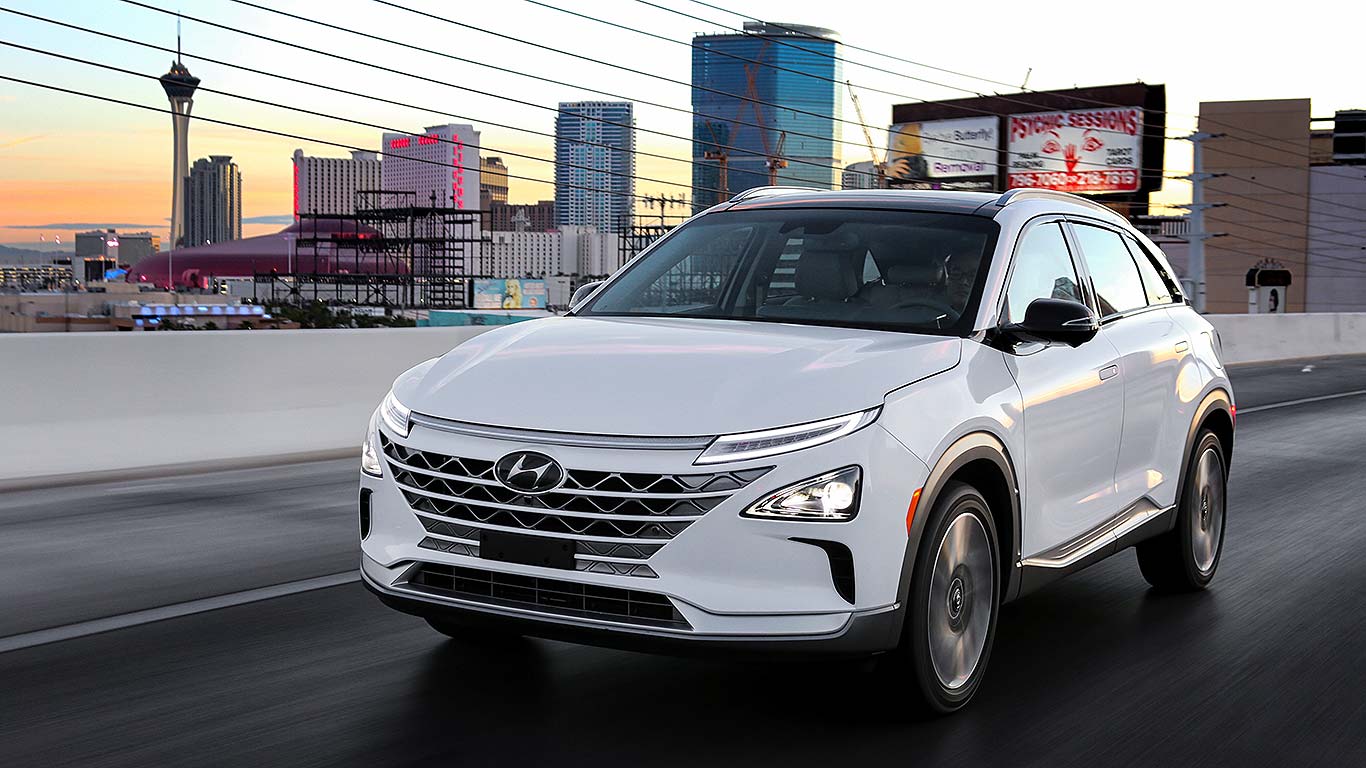
Hyundai had a new concept car for CES 2018 too. Called FCEV Nexo, it’s the firm’s latest fuel cell car, and the first bespoke-designed one. We should rightly be rather excited by this one: Hyundai confirmed a production version will be on sale later in 2018. What we see here is thus a thinly-disguised showroom-ready model.
It follows on from Hyundai’s pioneering ix35 hydrogen fuel cell car, of which it has produced several thousand, many of which remain in active service. The lessons learnt from that car have all gone into the new Hyundai Nexo.
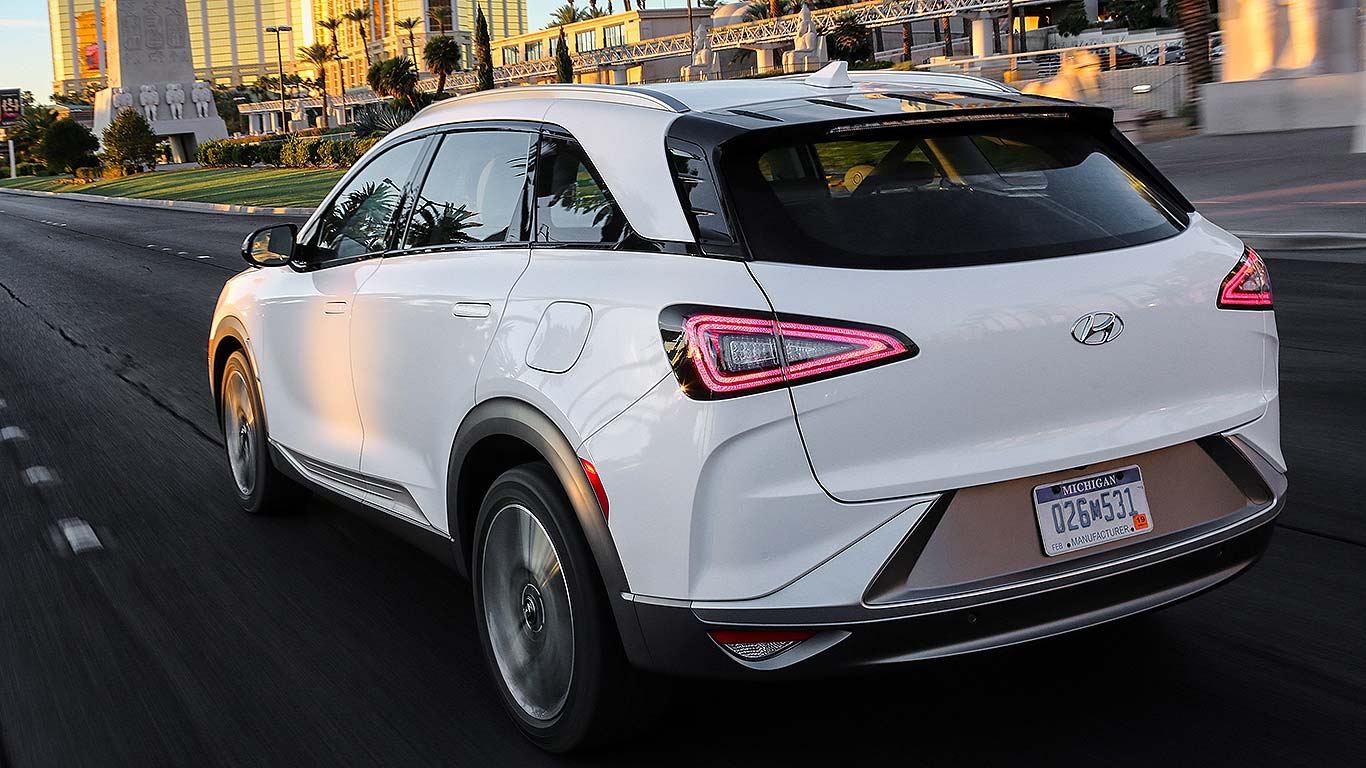
A smart, modern-looking SUV, Hyundai’s promising a driving range of 500 miles on a full tank of hydrogen, plus faster acceleration and shorter refuelling times. It will also include autonomous driving functionality and an industry-first blind spot view monitor: it shows the rear and side view when changing lanes, so the driver can keep their eyes forward.
The FCEV will be one of 18 so-called ‘eco-friendly’ vehicles Hyundai is promising to launch by 2025. Along with the Honda Clarity, Hyundai’s leadership in the production-spec hydrogen fuel cell sector continues to stretch ahead of rivals. How valuable may this competitive advantage be in the future, we wonder?
Toyota e-Palette Alliance
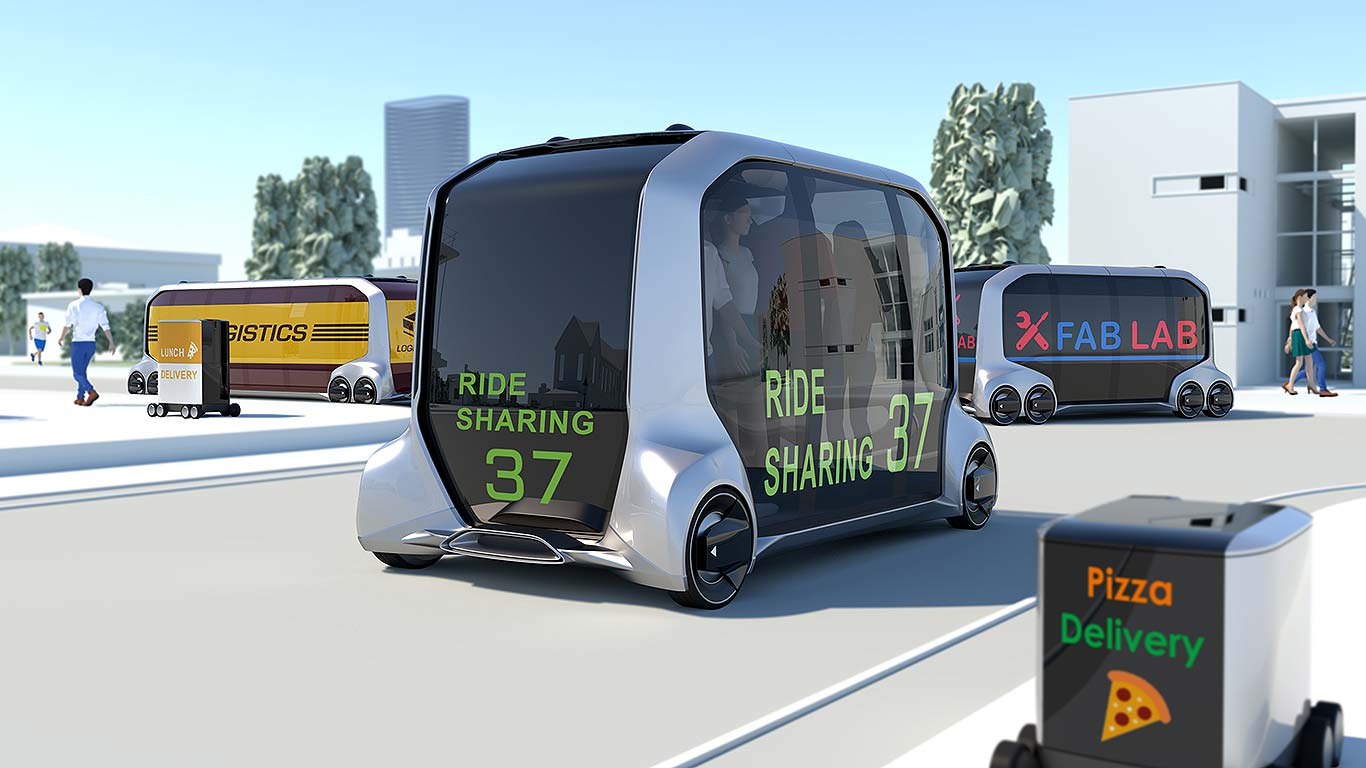
There’s a new automotive term we need to get familiar with: Mobility as a Service, or ‘MaaS’. This is where companies such as Uber, Amazon and even Pizza Hut will transport goods, people or take away pizzas via autonomous cars – and Toyota wants to be a car company offering them a basic vehicle which they can then develop and customise (a bit like a van is today, but far, far more technologically advanced and open).
The e-Palette Concept Vehicle is its idea of a fully-flexible purpose-built autonomous electric vehicle, into which those companies can add their own tech to better serve their customers. Fully scalable and customisable, even down to open source software, Toyota’s offering it as part of a new e-Palette Alliance that will collaborate to make the mobility ecosystem concept a reality.
Suddenly, the idea of an autonomous vehicle delivering your pizza, or your purchases from Amazon, or even picking you up for a ride, seems a little less far-fetched than it was…
Toyota automated driving vehicle 3.0
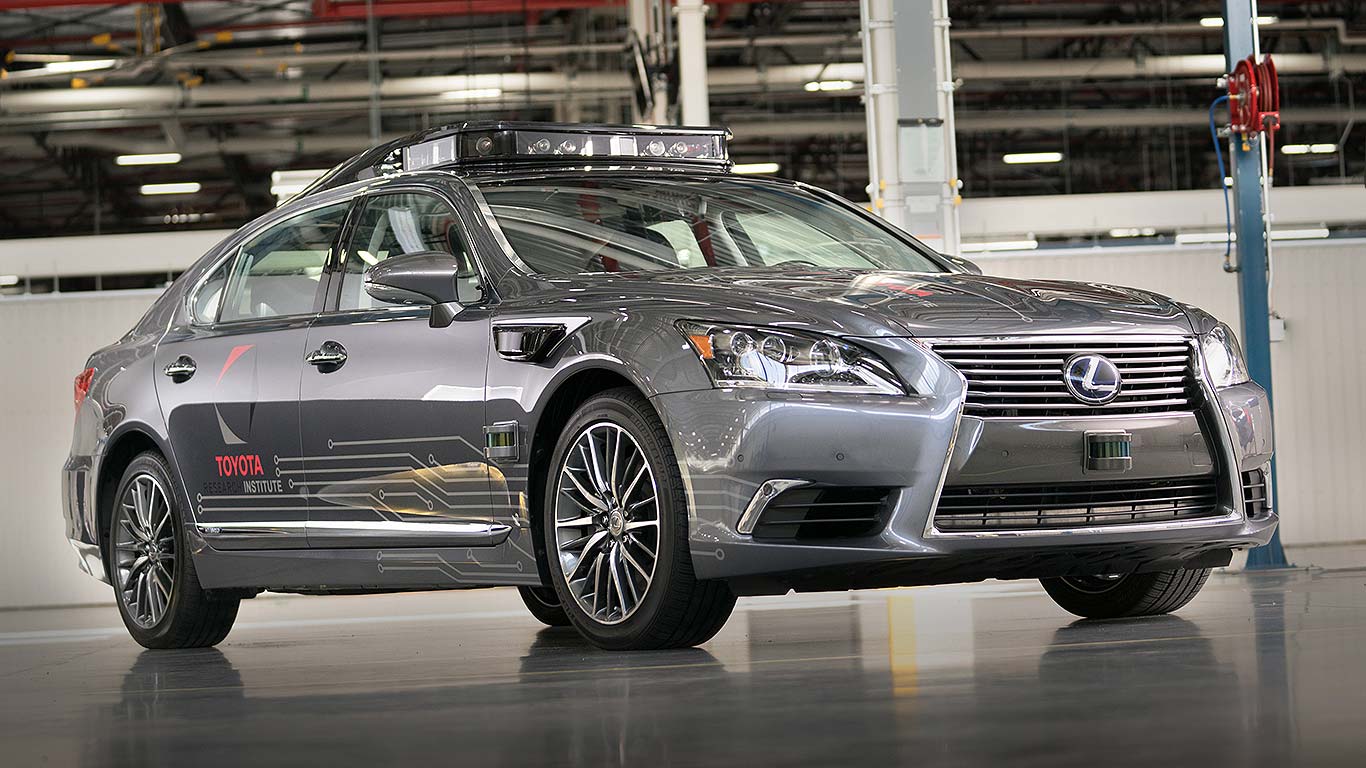
This is the reality of today’s autonomous cars, though. Toyota showed off its latest autonomous driving research vehicle, called Platform 3.0, at CES 2018, based on a Lexus LS 600h L.
It’s a highly accomplished autonomous research vehicle, one that offers ‘pace-setting’ perception capabilities and even better packaging that should allow the firm to easily build a large fleet of autonomous cars. However, the firm also insists the sensing equipment is blended into the vehicle to make it appear “sleek and elegant”. Sure, it’s better than the bolt-on tech and ‘spinning’ LIDAR sensors we’ve seen to date, but it’s still a long way from being smart enough to go onto a production car.
Fisker Orbit
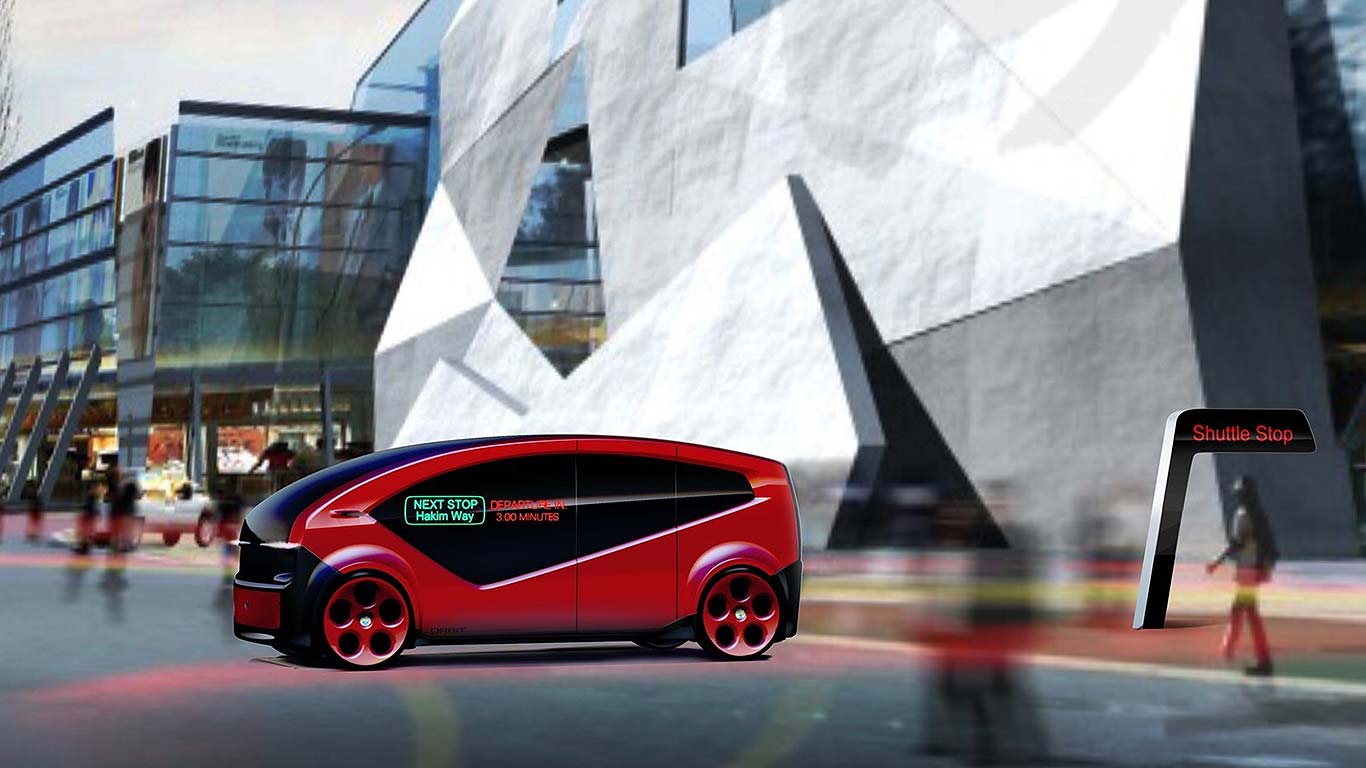
Fisker has a ‘Maas’ autonomous shuttle too – and this one, it says, will be in production by the end of the year. The body, passenger-centric machine shows off departure times and details of the next stop on its side window, and Fisker reckons it’s tailor-made for use on university campuses, business parks and research sites.
It’s being developed in association with Chinese firm Hakim Unique Group and already has its first application confirmed: the giant Chinese city of Hangzhou.
Mercedes-Benz MBUX
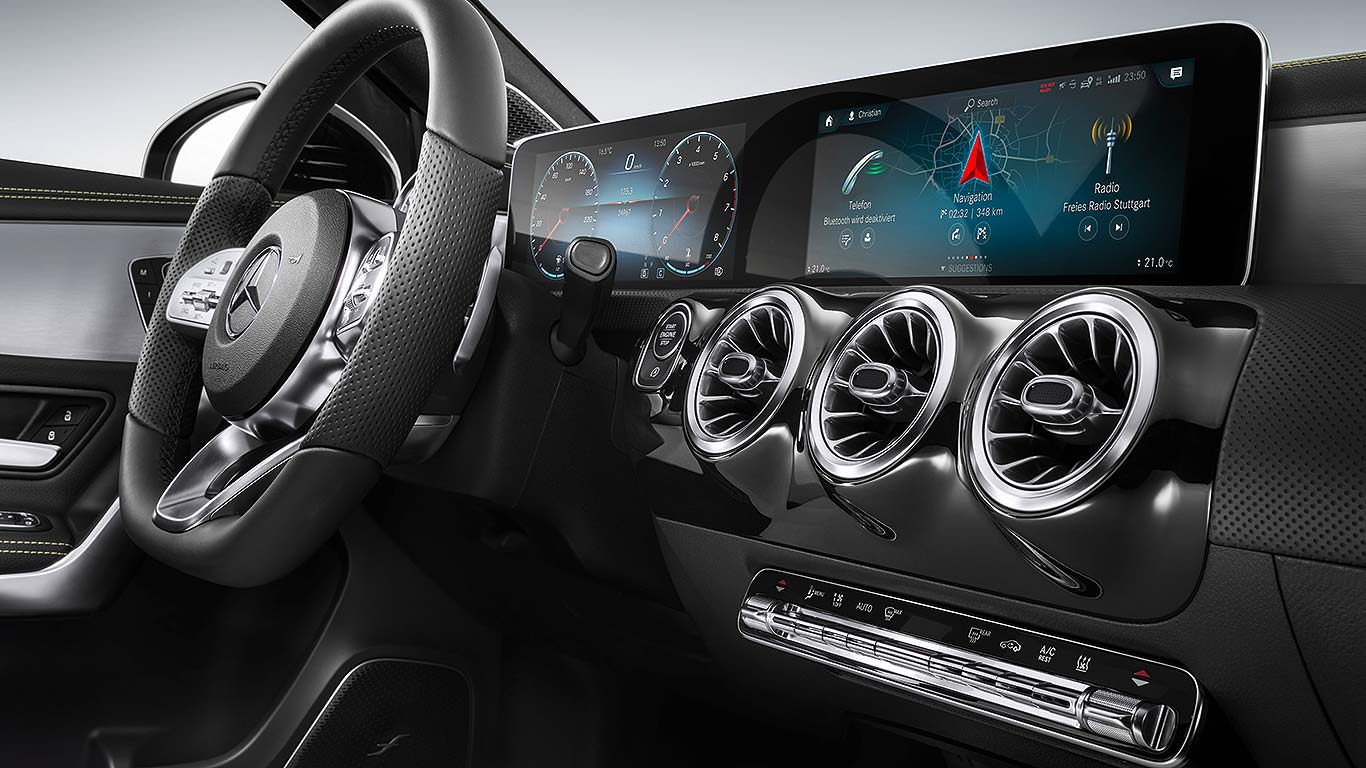
There’s a new Mercedes-Benz A-Class due in 2018, and it’s set to be the first Merc to get the firm’s all-new interior user interface, which it’s calling MBUX – Mercedes-Benz User Experience. This, along with some of the new car’s interior, was revealed at CES 2018.
Dominated by a widescreen cockpit layout, it offers over-the-air updates and artificial intelligence. The navigation has augmented reality functionality and intelligent voice control features natural speech recognition.
How to activate this? Say, “Hey Mercedes”.
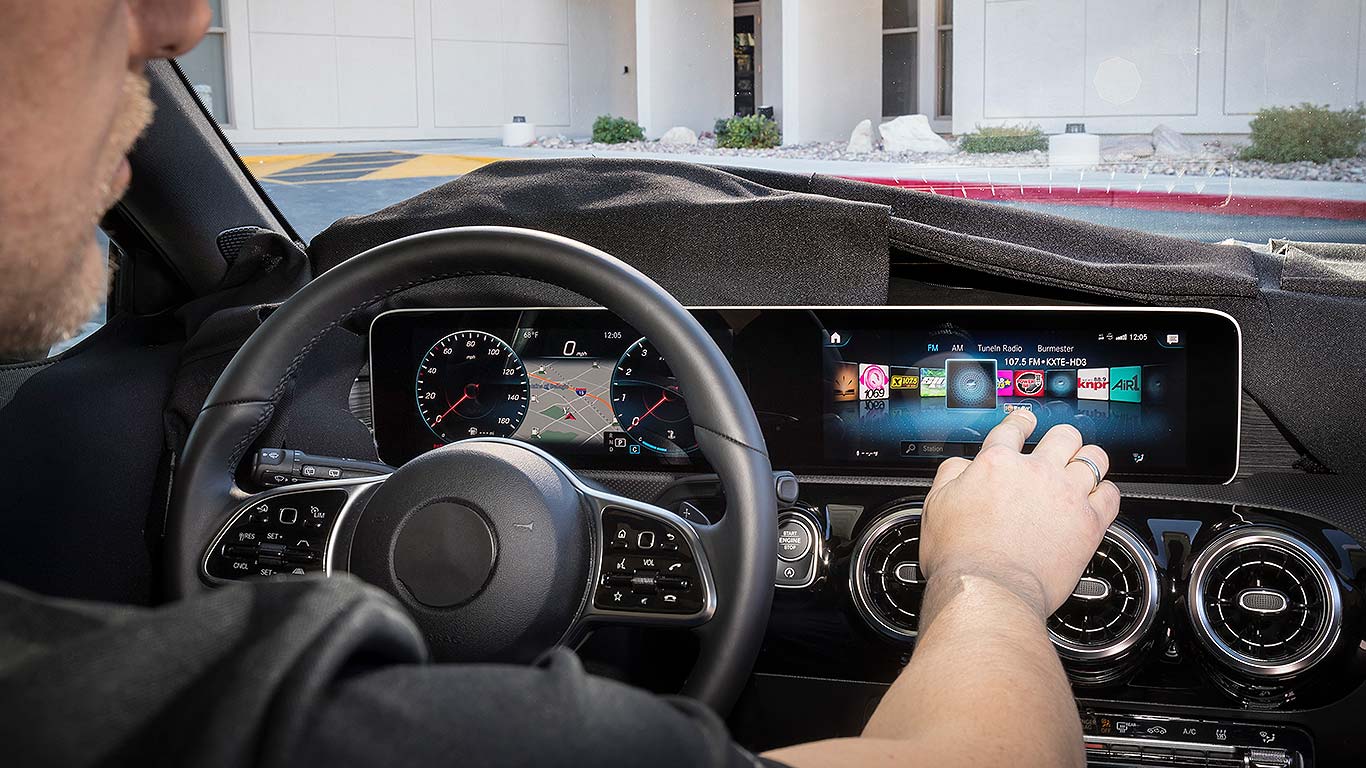
Mercedes-Benz engineers are bullish. The new system, powered by NVIDIA chipset and graphics, will turn the new A-Class into a genuine mobile assistant, and its ability to learn “is spectacular, and unique to date in the car industry. We are using artificial intelligence to give the user individual suggestions based on their habits.
“The algorithm we use for this is optimised for on-board use in the vehicle and exploits the opportunities afforded by the latest chip generation.” But it won’t be overwhelming, adds the firm. It offers flexible interaction via touchscreen, rotary controller or voice, and there are three different levels of information density: Homescreen, Basescreen and Submenu. Hopefully proving easier to use than today’s rather complex Merc infotainment system…
BMW drifting and refuelling
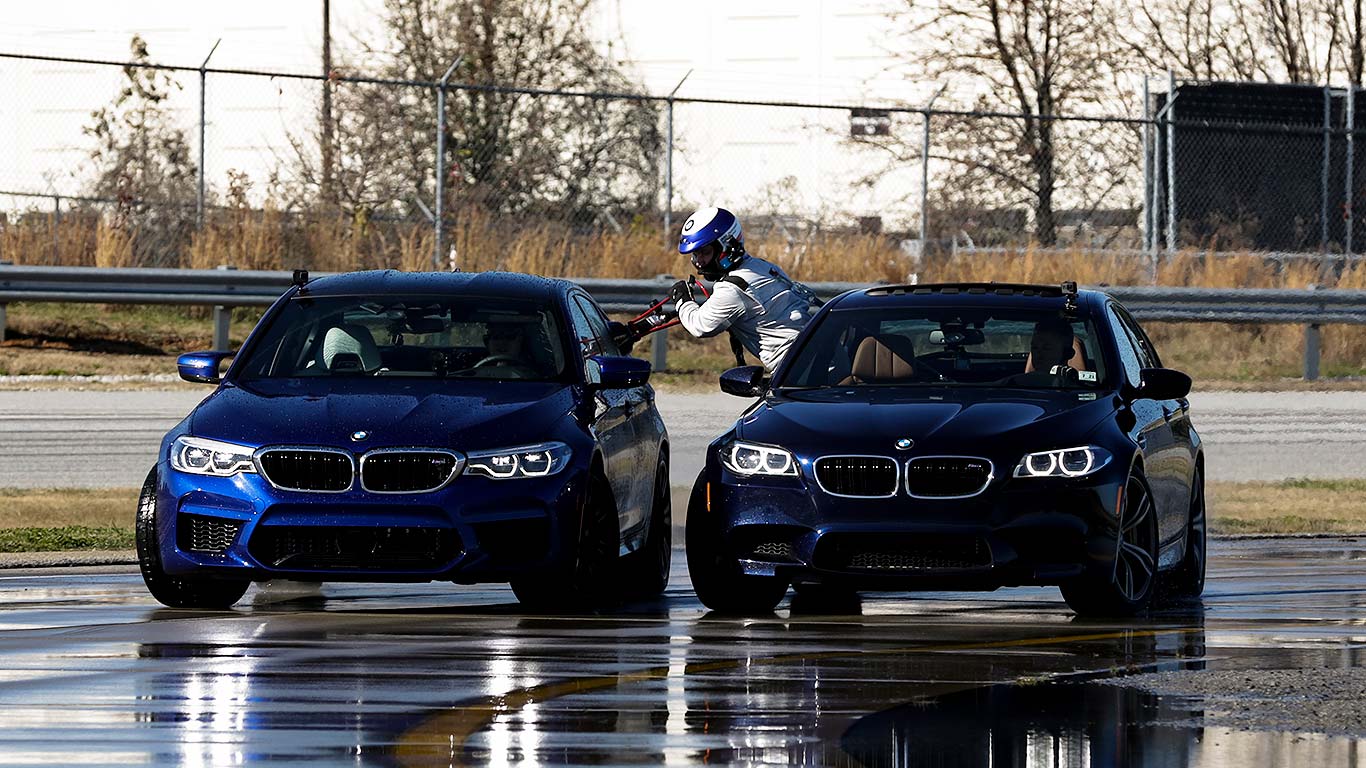
What’s CES got to do with BMW breaking its own Guinness World Records title for longest twin vehicle drift, with a 232.5-mile run in the new BMW M5? Because it was tech that made it possible.
The only way to raise the bar further was to find a way of refuelling the M5 mid-drift – otherwise, you’d simply be limited to the range of the tank. Enter North Carolina’s Detroit Speed, which designed a high-tech dry break fuel system based on the principles of mid-air fighter jet refuelling. Result? One single drift for the entire eight-hour run allocated by Guinness World Records. And, at CES 2018, one title-setting vehicle on display in the Las Vegas Convention Center, plus on-the-hour drifting demos in the parking lot by title holders Johan Schwartz and Matt Mullins.
Nissan brain-to-vehicle technology
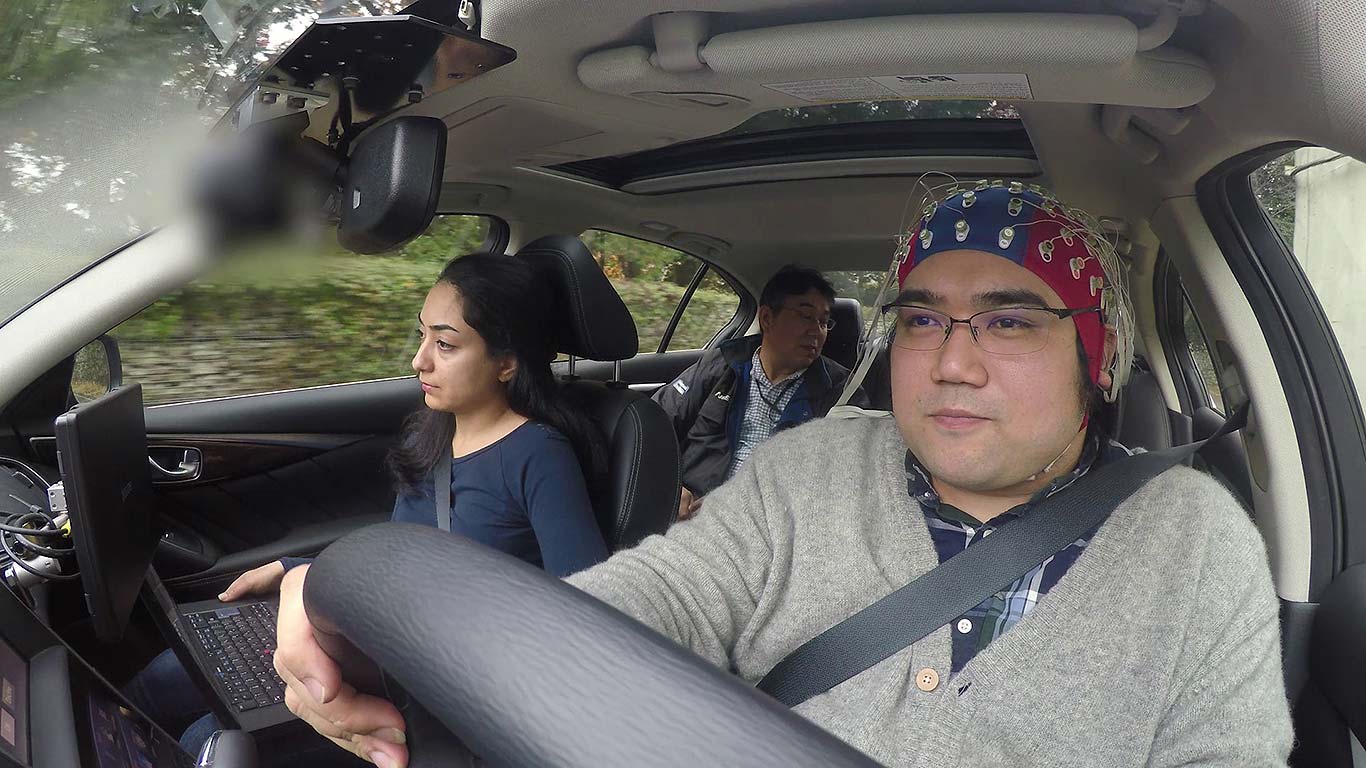
It’s called Brain-to-Vehicle technology, or B2V. Ignore the bizarre contraption this guy’s wearing on his head, and listen to Nissan’s explanation of why it’s developing it: by interpreting signals from the driver’s brain, reaction times will be speeded up (by up to half a second, says the firm) and, in time, cars will even be able to auto-adapt to the driver’s mood, “redefining how people interact with their cars”.
It’s a system that both predicts and adapts: when the car is in autonomous mode, for example, any driver discomfort could be sensed and the vehicle altered accordingly. “The potential applications of the technology are incredible” reckons Nissan. If, that is, it can make the B2V hat a little less scarily sci-fi…
Uber self-driving cars
Uber is quickly stepping up its test fleet of self-driving vehicles, using modified Volvo XC90s. At CES 2018, it announced that NVIDIA technology will now power the crucial Artificial Intelligence computing system. The ever-growing tech supplier is a big name in computing but is increasingly becoming a key automotive supplier. The latest Uber deal is thus significant.
NVIDIA AI tech will allow the Uber self-driving vehicles to “perceived the world, predict what will happen next and quickly choose the best course of action”. The AI tech will complement NVIDIA processors already used in the self-driving Uber Volvo XC90s, which have already autonomously driven more than 2 million miles.
NVIDIA, and Intel, and Qualcomm
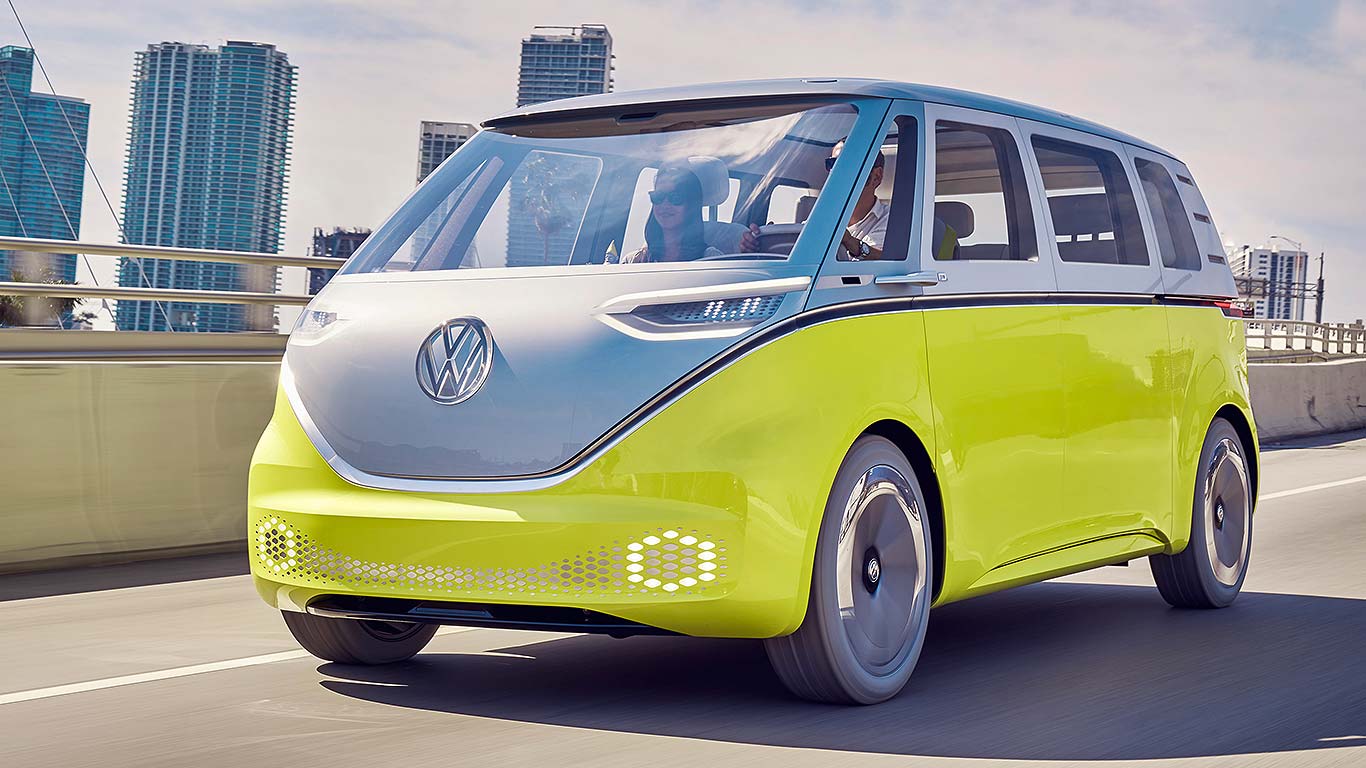
It’s not just Uber. NVIDIA is also supplying AI tech to Volkswagen, for use on its future electric cars including the I.D. Buzz. A combination of AI and deep learning will help power the cars’ self-driving functionality, but also many of the onboard functions such as voice, gesture and facial recognition.
Volkswagen will use the NVIDIA Drive IX Intelligent Experience platform to give the new cars auto-unlock by facial recognition, natural language voice control, gesture control and other neat capabilities it’s dubbing ‘Intelligent Co-Pilot’. “In just a few years, every new vehicle should have AI assistant for voice, gesture and facial recognition as well as augmented reality,” said charismatic NVIDIA founder and CEO Jensen Huang.
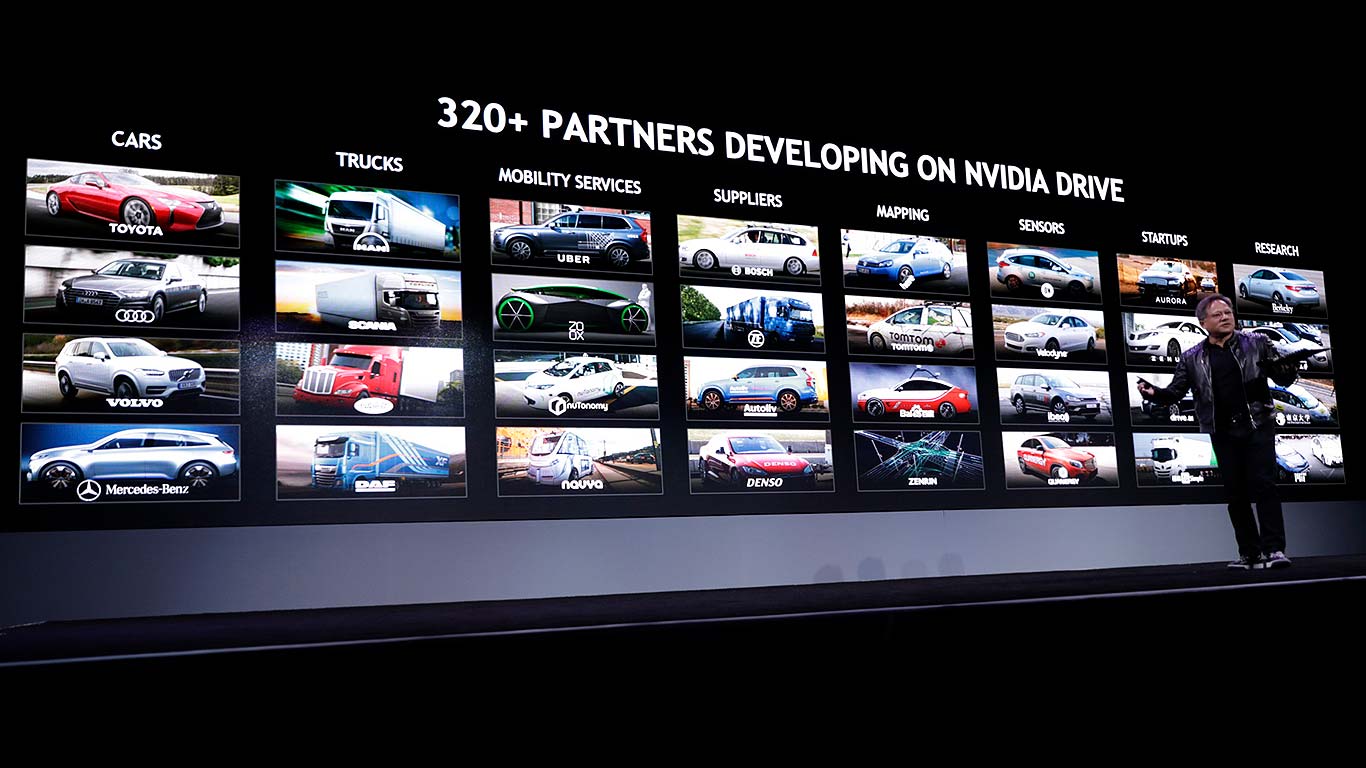
Here, incidentally, are some of the people NVIDIA is currently supplying its latest NVIDIA DRIVE AI car computer tech to. Think of it as the chipset and software equivalent of Bosch, Continental, ZF or GKN.
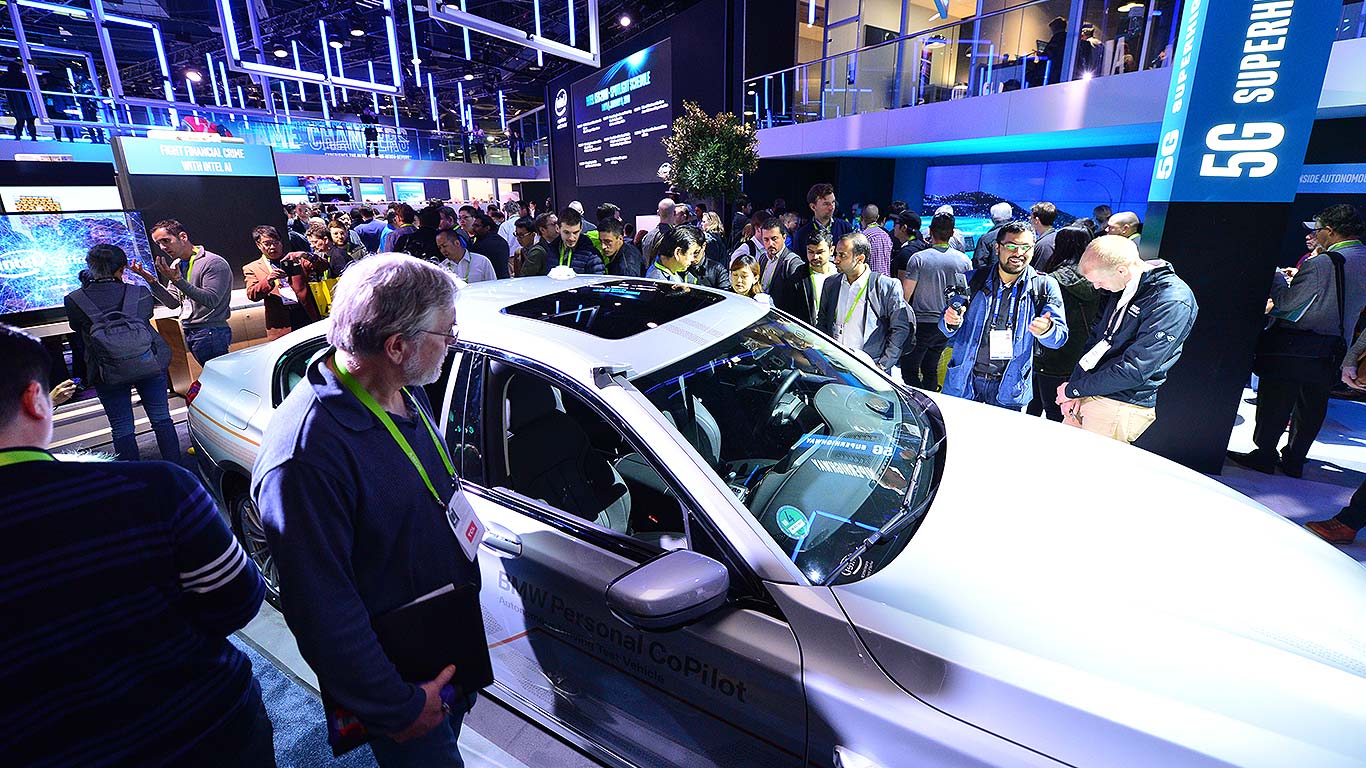
But it’s not just NVIDIA that’s amongst the new wave of automotive suppliers. Intel, for example, is stepping up shipping its Mobileye tech to brands such as BMW, Nissan and Volkswagen. This crowdsources data to rapidly build high-definition maps, of which the accuracy, detail and currency will be absolutely critical to self-driving cars. Already, Mobileye has over 2 million applications, claims Intel.
Qualcomm is yet another automotive tech supplier. Future Jaguar Land Rovers will use its latest Snapdragon 820Am Automotive platform, giving fast connectivity, Tesla-style over-the-air updates and “limitless in-car entertainment”. It will also help bring 5G tech to future models. The new relationship should accelerate the rapid gains JLR’s making with its cars’ infotainment systems, an area in which it for years lagged its premium rivals.
5G telematics in cars
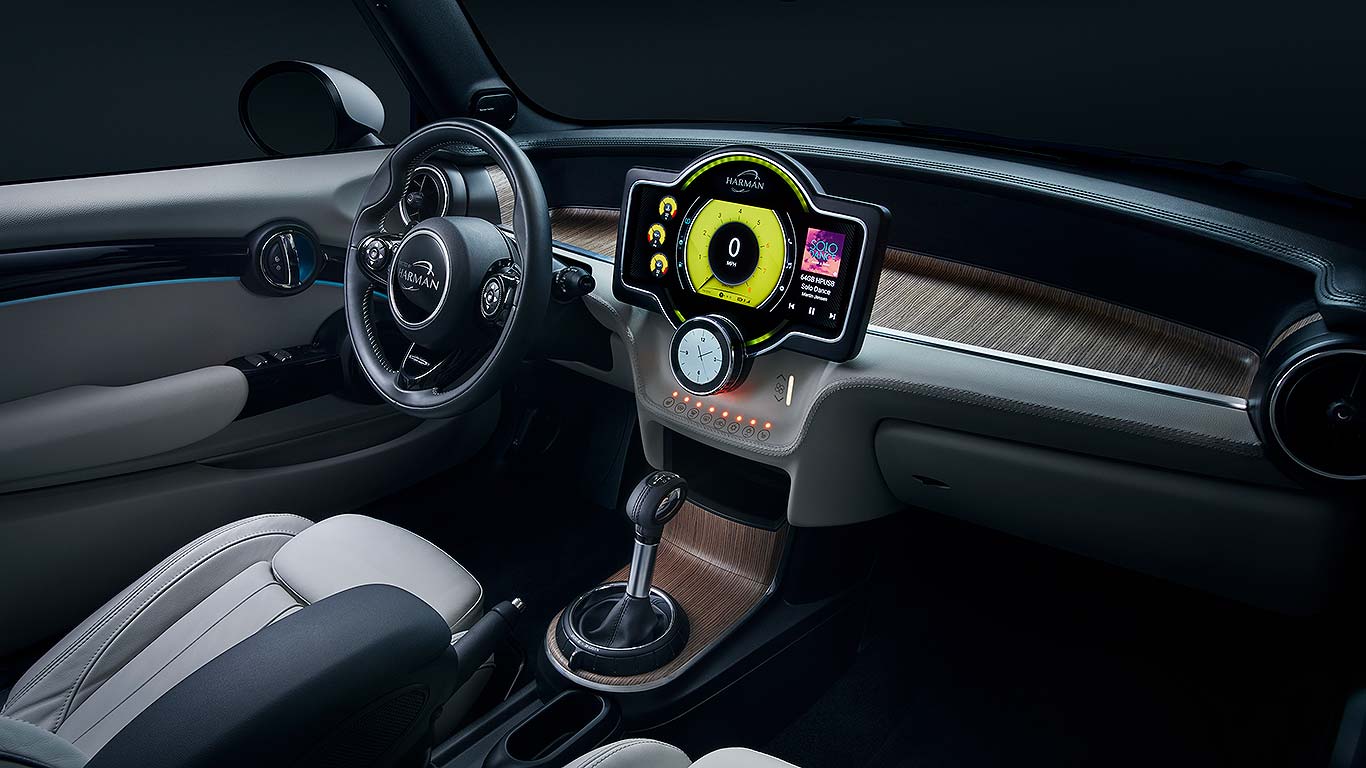
How do you fancy 5G automotive telematics with a whopping bandwidth of 1 Gb per second? Thanks to Harman and Samsung, it may be coming soon: the automotive supplier is the first to produce an automotive-grade 5G-ready telematics system that it says is 100 times faster than today’s 4G solutions.
This is set to deliver faster streaming, fully-immersive virtual- and augmented-reality features, plus reliable cloud-based automotive functionality and storage for tomorrow’s data-hungry autonomous cars. Who will get it first? “A leading European automotive manufacturer” says the firm. Any guesses as to who that will be?
Rinspeed Snap
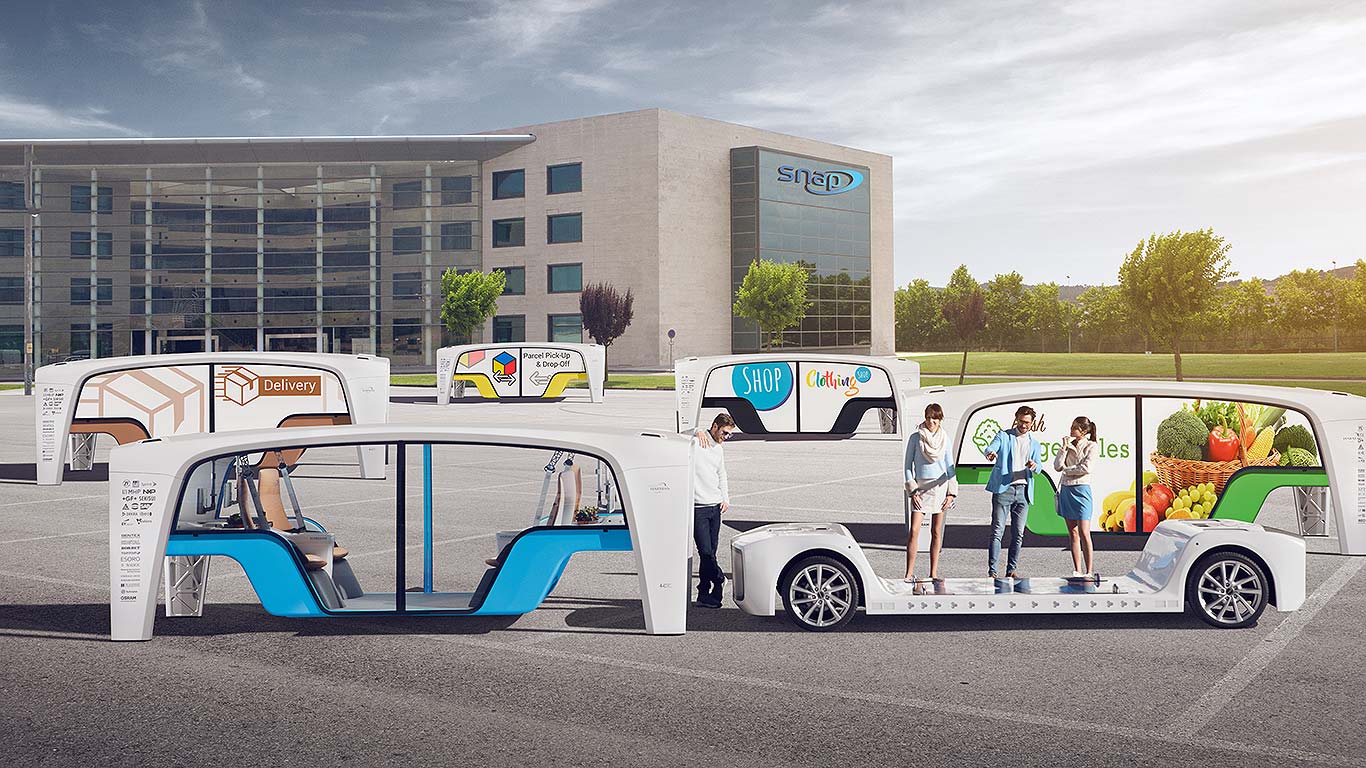
The car of the future will have expensive hardware and software built into a ‘skateboard’ chassis, upon which a removable passenger ‘pod’ will be mounted. So believes Rinspeed, which says it’s the obvious way to build cars in the future – swap the expensive, fast-dating software when new tech comes along, but keep the flexible passenger pod on top which you can customise as you wish.
The Rinspeed Snap is an attention-grabbing way of demonstrating this. The IT stuff below is recycled after a few years, while the pod on top is kept for much longer. This is greener, enables faster throughput of new technology, and offers the automotive industry an intriguing vision of how to solve the conundrum of different parts of tech-packed cars having different life cycles. If only we could do the same with the infotainment systems of our middle-aged motors today…
Ford ‘Cellular Vehicle-to-Everything’
C-V2X. What does that even mean? Ford and Qualcomm are proud of it, announcing at CES 2018 they’re to collaborate on it, and will launch trials of C-V2X cars in San Diego and Detroit later in 2018.
And what is it? A means of connecting cars to their surroundings: that’s other cars, roadside infrastructure, pedestrian’s devices, even traffic signals. Robust V2X comms are going to be crucial for autonomous cars, helping them ‘see’ things that are out of view, particularly when augmented by ultra-fast 5G cellular data transfer. Ford’s already working hard on autonomous cars: it will be hoping this announcement can help it gain an advantage in smart connected cars as well.
Honda robotics
Automotive technology needn’t just be about self-driving cars and fancy infotainment systems. Honda is a famous champion of robotics and announced its new 3E Robotics Concept as CES 2018.
The three ‘Es’ are Empower, Experience and Empathy. Honda reckons robotics and AI will in the future assist people and “expand their life’s potential”. Helpful, empathetic, friendly robots, that work together as a system. ASIMO’s family is set to grow.
Hyundai ethernet in cars
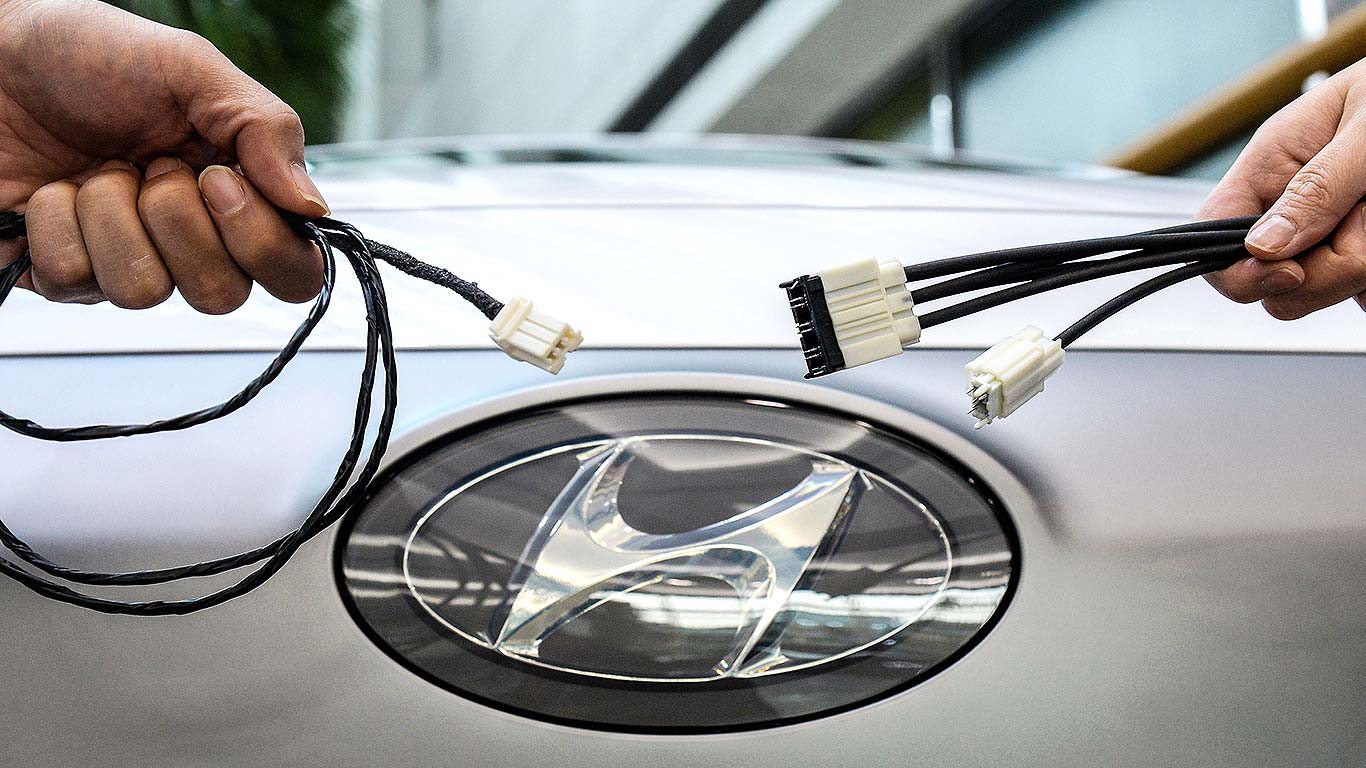
Isn’t ethernet technology something that’s already been and gone on personal computers? Maybe, but most cars today use even older CAN bus technology, which was hot back in the 1990s, but is alarmingly laggy once you start loading it with today’s data-heavy tech.
The answer is in-car ethernet, and Hyundai is bringing this to production cars from 2019. Capable of processing 1 Gb per second, Hyundai’s teamed up with Cisco to deliver it, giving its future cars the broadest possible bandwidth for the expected ultra-large datasets that will be used in tomorrow’s cars.
Harman QLED interior display
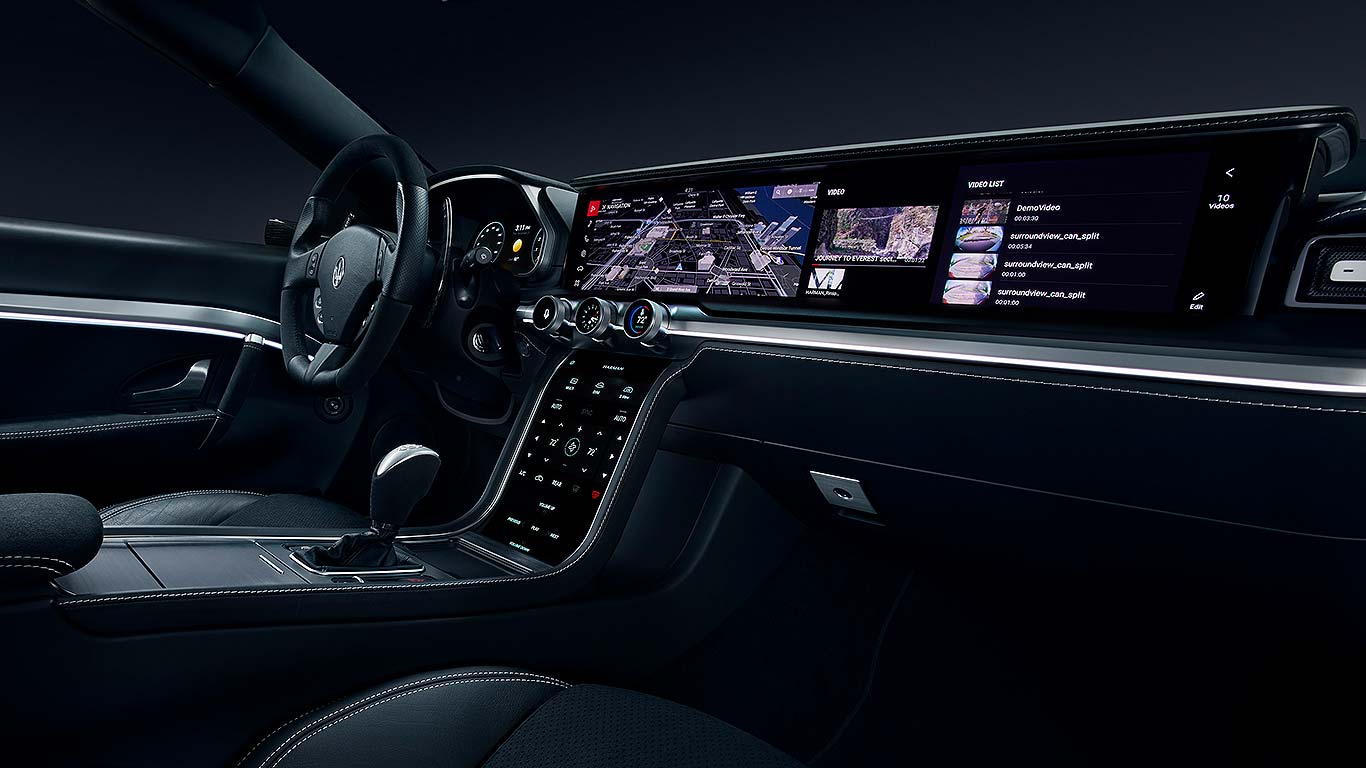
Feast your eyes on this deliciously rich display. Starring in a converted Maserati Levante, it’s Harman’s world-first automotive-grade QLED display – that stands for Quantum Dot Light-Emitting Diode, and is new tech that’s even better than today’s in-demand Organic Light-Emitting Diode (OLED) displays.
QLED is crisper, sharper, more flexible, more efficient and fully scalable. It’s so advanced, it can produce a range greater than 100 percent colour volume (more than the eye can see, in other words) and is tech that’s fully comparable with the latest, greatest personal electronics. It’s coming soon and will help carmakers integrate even more screens and displays into multiple interior surfaces, without having to charge car buyers a fortune.
Panasonic’s JLR Touch Pro Duo
Panasonic demonstrates the key role tech suppliers play in automotive these days. Remember the buzz around the Range Rover Velar’s amazing Touch Pro Duo infotainment system? Turns out that’s Panasonic technology, using cutting production technologies. The screens comprise multiple layers of touch foils, prints, tint and optical resins, bonded and mounted in flowing polycarbonate.
The lower 2K display even has solid aluminium dials, which use Panasonic Magic Ring Control tech, and both screens are anti–scratch, fingerprint-resistant and display information almost as if it’s floating above the display surface. Just another example of what tech firms are doing to make even the cars of today more alluring.
Harman AudioworX
Premium automotive audio is big business. The latest development is Harman’s AudioworX, a new open audio platform that will make it easier for sound engineers to create innovative new in-car sound experiences. Harman, like many rivals, already does hardware really well: that area, largely, is cracked. Today’s big gains will come in honing the software, and this is what Audioworx allows.
It’s hoping this new platform will “redefine” in-car sound in the future, and also allow carmakers to better differentiate different brands through in-car audio. “In standardizing the audio operating system, Harm is opening up the world of lifestyle autonomous audio to the creativity of all OEMs, audio engineers and enthusiasts alike,” says Harman president Michael Mauser. It will “push the boundaries of what’s possible in vehicles”.
Kia Niro EV Concept
The rather disappointing Kia Niro hybrid is set to become a bit more relevant in the future when it goes all-electric – and the concept version was showcased at CES 2018. It’s Kia’s EV equivalent to the Hyundai Ioniq Electric, and Kia’s talking of a 238-mile range from the 64 kWh battery pack, and decent performance from a 150 kW electric motor.
It’s fitted with a new Active Pedestrian Warning System, which uses front cameras, front speakers and object recognition technology. When it senses, say, a pedestrian or cyclist, it sounds a warning directed at them, and also flashes the light in a “highly intuitive” way so they know what the car’s up to. Just what’s needed, given how silent and surprising electric cars can be…